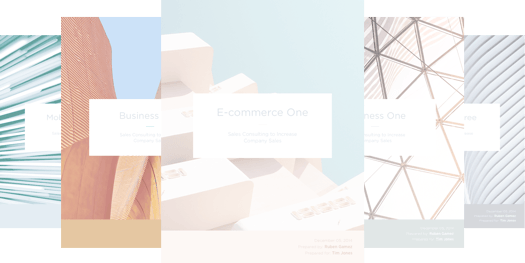
What do they even mean?
How can you come up with one that’s halfway exciting to read?
This document, a key part of your proposal package to large corporate clients, doesn’t have to be a bore. On the contrary. Done well, it can captivate even the busiest of executives and motivate them to pull your proposal aside for their employees to read in full.
Once you get past all the misconceptions about executive summaries, it’s a matter of embracing a persuasive structure to present the right information – in the right order – to make them work for you.
Let’s get started!
The Gatekeeper to Your Proposal
A poorly-written executive proposal can tank even the best proposal.
That’s because the executive summary acts as a gatekeeper to your full proposal. If it doesn’t impress its audience (think upper executive with a soul-crushing schedule) right away, they have little reason to read on. Most of them won’t.
Tom Sant, a consultant and proposal expert, sums up the importance of executive summaries well:
The executive summary is the single most important part of your proposal. It’s the only part that’s likely to be read by everybody involved in making a decision. In fact, it’s the only part of your proposal that some decision makers may read.
It’s heartbreaking when you spend time creating the perfect proposal, but your executive summary fails to persuade anyone to give it a look.
Where do executive summaries go wrong?
A lot of businesses either: 1) underestimate the importance of executive summaries and throw them together at the last minute, or 2) work hard on them but focus on the wrong information. In either case, the effect is the same: not much interest in your proposal.
What Is an Executive Summary?

The term “executive summary” sounds boring and formal. It calls to mind something you’d find in a 1950s corporation with miles of red tape and bureaucracy – or alongside TPS reports in the movie Office Space.
Because “executive summaries” sound boring, that’s often how they turn out. This term is in desperate need of a facelift!
It’s logical to assume an executive summary is just a brief overview of the contents of your full proposal…
But that’s not quite right. According to Tom Sant, it’s a standalone persuasive document. It lays out the business case why a client should hire you – without going into the level of detail found in a full proposal.
Where a proposal combines informative and persuasive, the executive summary focuses on persuasion. This resonates well with busy executives, many of whom will quickly scan it and focus on a few keywords. For this reason, the vast majority of summaries should be two pages at most. One is ideal.
Details are much less important here than positive business outcomes. Above all, executive summaries are opportunities to show clients you understand their needs and can deliver the results they’re looking for.
When to Use Them
Executive summaries are best suited for complex projects with large corporate clients.
In the vast majority of projects, the client can simply read through your proposal in its entirety. But if it entails complicated milestones, a big budget, and lots of moving pieces, it’s a good idea to include a summary to offer a bird’s-eye view of your recommended solution.
These large-scale projects typically also include a cover letter. So the proposal package goes: 1) cover letter, 2) executive summary, and then 3) proposal. The first two documents persuade the audience to keep reading, and the proposal persuades them to hire you.
Always use an executive summary when a client explicitly asks for one. It’s amazing how many of your competitors will disqualify themselves by not following straightforward instructions. The first step to convincing a client you’re the best choice? Follow the requirements laid out in their RFP to the letter.
When to Write Them

A lot of entrepreneurs write their executive summaries after finishing their proposals. This makes sense logically. After all, it’s easier to summarize something that has already been written.
A more counter intuitive – and effective – approach: write your executive summary first.
This takes time up front, but doing the work helps guide your focus in the full proposal. It’s kind of like having a loose outline to walk you through the process.
Like an outline for a fiction novel, your executive summary doesn’t have to rigidly define what your proposal must contain. It’s a loose guide. If you come up with a few good ideas while writing your proposal that veer a bit off course, you can always go back and tweak the executive summary once the proposal is finished.
Taking care of your executive summary first will also help you avoid feeling rushed. It gives you an opportunity to really think about your strongest selling points – and present them effectively.
Bottom line: there’s no set formula about when to write the executive summary. But it doesn’t have to be at the end. Experiment with different ways and figure out what works best for you.
Try This Persuasive Structure
While the proposal and executive summary have a different purpose, their structure is practically identical. This framework will help you capture the attention of busy executives and show them you’re the best choice – no matter the project or industry.
In his book Persuasive Business Proposals, Tom Sant outlines his basic N-O-S-E structure to ensure every executive summary is persuasive and client-focused. I’ve added one more step at the end, a call to action, to help close out the document and maximize conversions.
Needs

This is the most important part of the executive summary. It’s also where a lot of people go wrong.
The temptation is strong to launch into why your company is the best choice right away. You have the talent, experience, and vision to carry out this project like no one else. Wouldn’t you want the client to know?
Not quite yet. You can’t convince someone you’re the best choice to solve a problem before clarifying exactly what that problem is. That’s why needs identification comes first.
What is the pain point that drove the client to seek help? You might not find it within the RFP, which is often heavy on project specs but light on business motivation.
To pinpoint the need, go deeper. Researching recent developments at the client’s company – and within their market at large – will help you get a sense of the big picture. Once you discover the business need behind the project, you can lead with it and make a great impression.
Here’s how it might look if a full service digital agency wanted to work with an electric car company:
You have experienced an average 3% loss in market share over the past four years. As the alternative fuel market matures, reclaiming market share is a challenge with an increasing number of direct electric competitors and hybrid models…
Here’s how it might look if a streaming video service needed a website designer and developer:
Metflix Prime has suffered a $155 million loss in revenue so far this year. Several of your paid focus groups found that challenges with the website interface and unreliable streaming drove a significant number of users to other platforms…
Here’s how it might look if a retailer needed help launching a new product line:
Beauty Boutique has had massive success with its brick and mortar stores, but it has yet to take advantage of all e-commerce has to offer. The upcoming launch of its shoe line is the perfect opportunity to prepare a strategy that integrates both brick and mortar and digital elements…
Outcomes

In this section, you get the reader imaging the best-case scenario. What would their business look like if their need or pain point was solved?
This ideal outcome goes beyond simply a project completed to specifications. It’s the business benefits that the completed project creates.
This depends on the industry and the specific project, but it’s almost always a variation of (or a combination of) the following elements:
- More money (more customers, better customer retention, increased size of average sale, more effective ad spend, etc.)
- More authority in their niche (better brand recognition, better customer service, etc.)
- More time
- Less frustration (streamlined processes, better security, etc.)
Lay out the ideal outcome as a result of your solution. If you can, be specific about the scale of the outcome in a measurable way. Saying you will increase monthly sales by 25 percent, for instance, is more compelling than just saying you will increase monthly sales.
Here’s how it might look for the automotive company:
Putting our digital marketing strategy into action will help you grow market share by 4% within the first year. In addition to driving more foot traffic to Auto Electro dealers, it will help you offer better support to current customers. That will increase the number of repeat customers and word-of-mouth referrals, both of which are key to sustained growth…
Here’s how it might look for the streaming video company:
A new website with custom functionality will make it much easier for users to browse Metflix Prime’s extensive catalog and watch videos. Hosting the videos on our servers will increase streaming reliability by more than 10%. We estimate these improvements will stop the shrinkage of the user base within the first six months…
Here’s how it might look for the retailer:
Launching the shoe line both digitally and in-store will more than triple the expected revenue than launching it in-store alone. This investment will also give Beauty Boutique the foundation to maximize profits from future product launches as well…
Solution

Once you’ve defined the ideal business outcome, give a brief overview of how you will create it.
This isn’t the time and place for too many details. Where your proposal is the place to get into specifics, the summary is best for a broad overview.
Focus on the big deliverables (a new website, a new customer management system, etc.). Each deliverable will probably require a suite of smaller services. Save those for your full proposal.
If you can, touch on a few differentiators about how working with you would make those deliverables more valuable than they’d be if the client chose someone else.
Here’s how it might look for the automotive company:
We are proposing a digital marketing strategy that incorporates paid advertising and content marketing over social media and the Auto Electro company blog. This approach is more cost-effective than TV commercials. It also increases brand recognition – especially within a younger demographic (21-35) most receptive to buying an electric car.
Here’s how it might look for the streaming video website:
We propose a fully redesigned website that makes it easier for viewers to browse the catalog, find specific titles, and watch them without issue. This website will load faster than the current version, as well as require less buffering to watch videos. Our custom functionality will also make viewing fast and reliable on a variety of devices…
Here’s how it might look for the retailer:
We are proposing a launch strategy that targets Beauty Boutique’s target demographic through traditional (magazines, TV commercials, etc.) and digital channels (social media, pay-per-click advertising, etc.). The launch website will create a fully-interactive experience where visitors can see the shoes from a variety of angles, colors, and materials. Visitors will be able to place pre-sale orders online and have their purchases shipped after launch…
Evidence

Two major concerns for corporate clients are getting the project done: 1) on time, and 2) on budget. The evidence section assures them that you’ll be able to accomplish both.
This is a rare opportunity to (briefly) talk about yourself. If you have experience handling a similar project in the past, or a track record of rarely coming in over budget, now’s the time to mention it.
The idea isn’t to brag about how great your business is; it’s to strategically focus on aspects that assures clients you’re the right choice.
Here’s how it might look for the automotive company:
We’ve helped eco-friendly brands appeal to like-minded customers in various industries. This helped us develop a strategy how to find and engage the people most likely to make “green” purchases…
Here’s how it might look for the streaming video service:
Our team helped Amazon fine tune its recommendation engine, which gives shoppers suggestions about other products to consider based on their browsing activity. We’ve came in at or below our estimated budget in 94% of all of our projects…
Here’s how it might look for the retailer:
We’ve helped Glitter and Co., Timeless Fashion and Sparkles launch new products online, just to name a few. All of these successful launches went forward without a delay…
Call to Action

A call to action is like a big flashing sign that says, “Interested? Here’s what to do next!”
While many upper managers will simply read your executive summaries and pass them off for others to analyze in full, some might have questions. A call to action gives them an easy way to get in touch with you.
This section also helps close out the document naturally. You can thank the client for the opportunity and reiterate that you’re eager to get started.
A call to action might look like this:
Our proposal goes into more detail about how exactly we’ll create these results, and what you can expect along the way. Thank you for the incredible opportunity. Feel free to pick up the phone and call me personally at 555-5555 if you have any questions.
A Few More Tips to Make Your Executive Summaries Even More Compelling
Following the structure helps you hone in on what to write about to appeal to busy clients.
Here are a few more tips to help you make the most of that persuasive structure:
- Keep it client-focused. It’s so tempting to try to impress clients by going on about your qualifications, experience, and accomplishments. In fact, that’s exactly what a lot of entrepreneurs do; their proposals end up in the trash bin. The most effective executive summary stays laser focused on the client. Tom Sant recommends a 3:1 ratio of using the client’s name to your name. Talk about yourself only in the context of the client’s specific business needs.
- Use clear, simple language to make the summary accessible for everyone. Most people who read executive summaries are busier than you can imagine. Even if they understand dry, technical jargon, they don’t have time for it. What they want are simple business outcomes. Omit repetitive words. Don’t use big words when smaller ones would do. Tell them how you can help them, in terms it doesn’t take a master’s degree in business to understand. You’ll always have time for technical details in the full proposal.
- Check for grammar mistakes and typos. Review your executive summary mercilessly for grammar errors and typos. Better yet, have several people go over it before submission. If an executive spots a typo in an otherwise flawless package, they’ll question your professionalism and ability to provide a solution.
- Don’t bring up the cost. Unless the client specifically asks you to list cost in the executive summary, you’re better off leaving it out. Seeing a dollar amount halfway down the page encourages people to make a snap decision (“it’s too expensive”) rather than reading the whole document to get a better sense of the value you can deliver.
Over to You
Most executive summaries are boring, but yours don’t have to be.
If you follow the tips above, you’ll transform your summaries from formalities to persuasive sales tools. This document, one of the most crucial parts of the proposal package, can grab the attention of busy executives and help you land the most lucrative projects.
Have you struggled writing an executive summary? What about them do you find the most challenging? Leave a comment below and share your experience!

